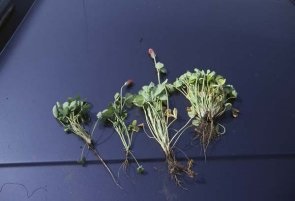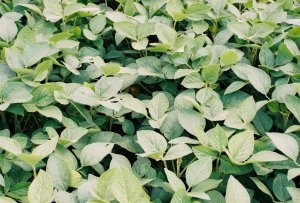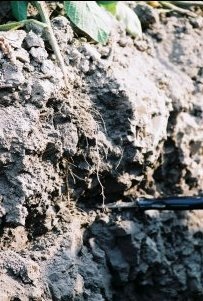Cover crops: other legumes
Information on the benefits and growth habits of soybeans and white, berseem and crimson clovers planted as a cover crop.
Soybeans
Description
Family
- Leguminosae
Growth Habits
Germination
- Can be created with leftover or discarded seed
- Will germinate quickly in warm, moist soils
Top Growth
- Short height growth
- Rapid cover if sown thickly
Overwintering
- Killed by frost - do not overwinter
- Need catch crop to prevent nitrogen leaching
Site suitability
- Wide range of soil conditions
- Less tolerant of low pH, droughty and saturated soils
Control Options
- Winterkills readily; controlled by tillage and chemical if necessary
Sensitivity to Herbicides
Weed Control
- There are many herbicides registered for use in soybeans but good weed control for a cover crop should not be expensive and may not be needed. Use narrow rows and a high enough plant population to establish a vigorous crop canopy as soon as possible.
- See OMAFRA Publication 75 - Guide to Weed Control for information on weed control measures
Benefits and Cautions
Nutrient Management
- Will release N and cause leaching in winter and spring
Pest Management
- Soybean cyst nematode (SCN) is a concern on many Ontario farms. Using a non-resistant variety of soybeans as a cover crop could encourage greater concentrations on farms identified with SCN.
Organic Matter
- Used as forage
- Residue readily breaks down
Getting Started
Establishment
- Planted in fall - but some double crop soybeans after early processing peas - this can become a soybean cover crop depending upon growing conditions
- Drill or broadcast seed at a rate of 80 to 100 kg/ha
- Germinate quickly in warm soils if planted into moisture
- Growth tends to be very short
Cost & Availability
- Seed is widely available
Clover (White, Crimson, Berseem)
Description
Family
- Trifolium spp
- Crimson Clover – Trifolium incarnatum
- Berseem Clover – Trifolium alexandrinum
Growth Habits
Germination
- Crimson - hardseeded
- requires moist conditions
- Berseem - same as crimson
- will tolerate a drier seedbed
Top Growth
- Crimson - 30 to 50 cm tall
- light - green foliage covered in soft hairs
- striking red flower tops the plant
- Berseem - 30 to 120 cm tall
- hollow stem, slightly-hairy leaves
- yellowish white flower
Root System
- Crimson - simple tap-root, well nodulated
- Berseem - short tap root - top 30 cm of root zone
Overwintering
- Both are intolerant of extreme cold conditions
- Not winter hardy
- Will behave inconsistently in regions (extreme southwest or Niagara) where winters are mild
Site suitability
- Crimson:Tolerates a wide variety of soil conditions;
- Does not tolerate poor drainage and calcareous conditions
- Has a pH range of 5.0 to 7.0
- Does best on well drained, humified, loamy soils
- tolerates shade
- Berseem: Range = loamy and clayey soils
- Prefers soils with high silt and very fine sand contents
- Tolerates poor drainage and drought better than Crimson
- Has a pH range of 6.5 to 7.5
Control Options
- Mowing + incorporation and chemical control will control clovers
Sensitivity to Herbicides
- Crimson – controlled by glyphosate; cyanazine or mixes of paraquat with 2,4-D, dicamba and cyanazine
- Berseem – controlled by glyphosate
Weed Control
- Clovers are frequently underseeded into a cereal crop and any weed control measures need to take crop safety of both crops into account.
- Read product labels carefully to determine if the clover species you prefer is suitable for the herbicide needed for your crop and weed situation.
Benefits and Cautions
Nutrient Management
- Ability to supply N not well documented for Ontario, estimates place them similar to red clover
- Due to winterkill – could lead to N loss from system in spring
Pest Management
- Both are attractive to nematodes – particularly root-knot nematodes
- Provide cover for beneficial insects
- Berseem – especially attractive to pollinating insects
Organic Matter
- Both have a C:N of @ 10:1
Getting Started
Establishment
- Requires firm, moist seedbed
- Can be broadcast or drilled
- Seed by six weeks before first killing frost - rate of 18 to 20 lbs/acre Crimson
- 9 to 25 lbs/acre Berseem
- Should be companion planted with mixtures of : rye, vetches, annual ryegrass, and various cereals for winter protection
Cost & Availability
- Seed is expensive and generally not available in Ontario
Updated: March 26, 2024
Published: August 24, 2022


